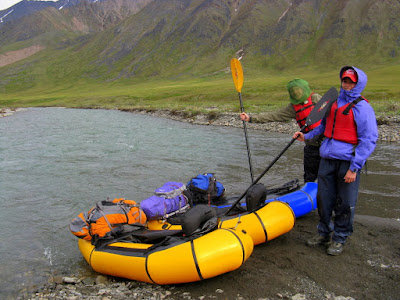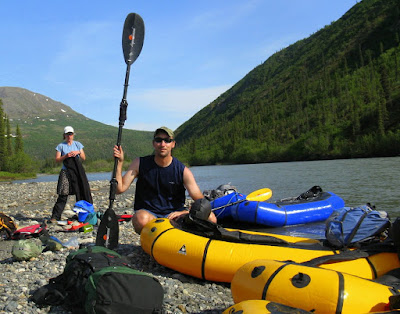
I looked back over my shoulder and they were still there. Completely lost in their thoughts and undoubtedly struggling to deal with the miserable situation. I began to seriously question my decision to bring two 15-year old kids on this trip. We had been stumbling across knee deep tussocks in the late afternoon heat fully draped in our armor of raingear for hours. The uneven surface made it nearly impossible to move in any direction. Each erratic and unstable step ended with a sharp roll of the ankle as we clumsily navigated through the maze of towering tufts of grass. But we had to keep progressing forward because the incessant humming of the mosquito filled atmosphere was maddening. The continuous ricochet of bugs against our bodies felt like a torrential shower of raindrops pelting our clothing. There was no choice but to move on to a place where the ground would firm up enough to allow us to setup camp and take refuge in our tent.
I knew better than to head to the Arctic this late in June but I thought we had a few more days of reprieve before the onset of bugs. We were a day too late. The season is short this far north and the tundra explodes with new life every hour during the start of the brief warm season and 24-hour sunshine. My nephew Mark and his friend Mara were up for the adventure and decided it was worth the gamble. So we spent summer solstice above the Arctic Circle in the shadow of spectacular folded limestone cliffs, fields of wildflowers, diving raptors, howling wolves, following the footprints of grizzly bears, and sacrificing ourselves to the hordes of blood thirsty mosquitoes.














Thursday, June 25, 2009
Kids on the Itkillik
Posted by
Ed Plumb
at
12:07 PM
2
comments
![]()
Labels: Packrafting
Monday, June 15, 2009
W. Fork Atigun Weekender

I suddenly felt a sense of relief as the last bit of warm blood vacated the few remaining vessels in my feet. I was no longer subjected to the excruciating pain caused by the snow and pools of slush that were penetrating my sneakers. I somehow convinced myself that no feeling is better than endless stinging. But I already knew that repeated inflictions of my feet to the cold over the years had resulted in permanent numbness to some of my toes. At this point I still didn't care. I just wanted to keep moving downhill to a lower elevation where green tundra and the first wildflowers of the summer dotted the valley bottom.





 Resourceful Sky chomps away on an abandonded caribou rack. She could survive a long time on small mammals and other treasures in the wild. The caribou had moved down out of the mountains to the coastal plain in preparation for calving.
Resourceful Sky chomps away on an abandonded caribou rack. She could survive a long time on small mammals and other treasures in the wild. The caribou had moved down out of the mountains to the coastal plain in preparation for calving.
Videography from the West Fork of the Atigun. Preparing for the final leg: a cold rain and driving headwind forced us to vacate the boats when our waterway skirted the Alaska Pipeline and road. Mildly hypothermic we ran the last 15-miles to the truck along the muddy highway outfitted in all our clothes and life jackets with the hopes of getting a ride...no ride came.
Preparing for the final leg: a cold rain and driving headwind forced us to vacate the boats when our waterway skirted the Alaska Pipeline and road. Mildly hypothermic we ran the last 15-miles to the truck along the muddy highway outfitted in all our clothes and life jackets with the hopes of getting a ride...no ride came.
Posted by
Ed Plumb
at
6:54 PM
11
comments
![]()
Labels: Packrafting
Monday, June 8, 2009
Coffee and Pizza Traverse

All I could focus on the last two hours of our float was shoving a giant piece of greasy pizza into my mouth. The pleasurable sensation of the melted cheese against my tongue and anticipation of the calories replenishing my body. Fortunately for me our weekend traverse in the Alaska Range would terminate at the same location we started at the day before - but this time there would be unlimited pizza fresh out of the oven waiting to be devoured.












Posted by
Ed Plumb
at
11:11 PM
6
comments
![]()
Labels: Packrafting

